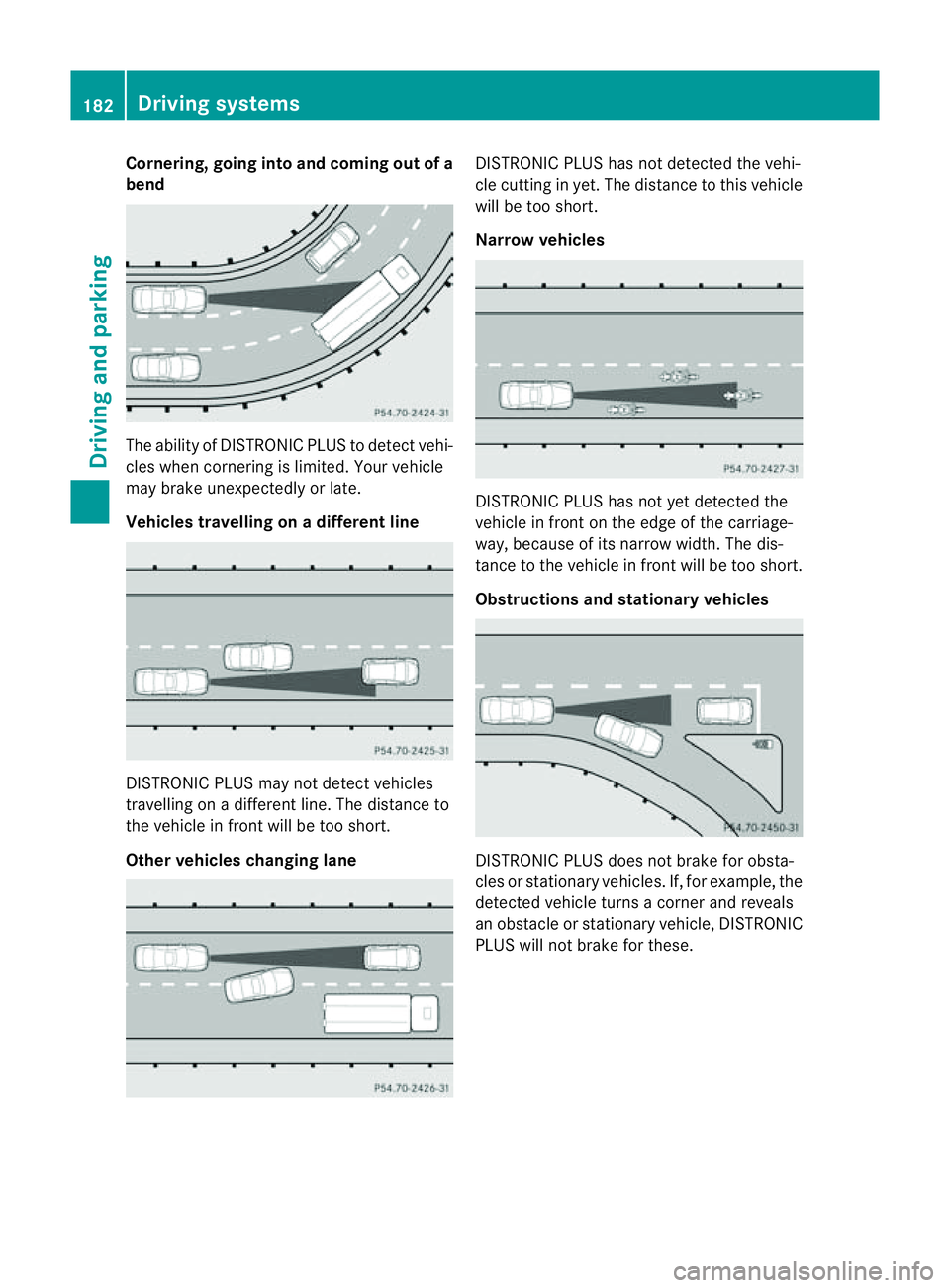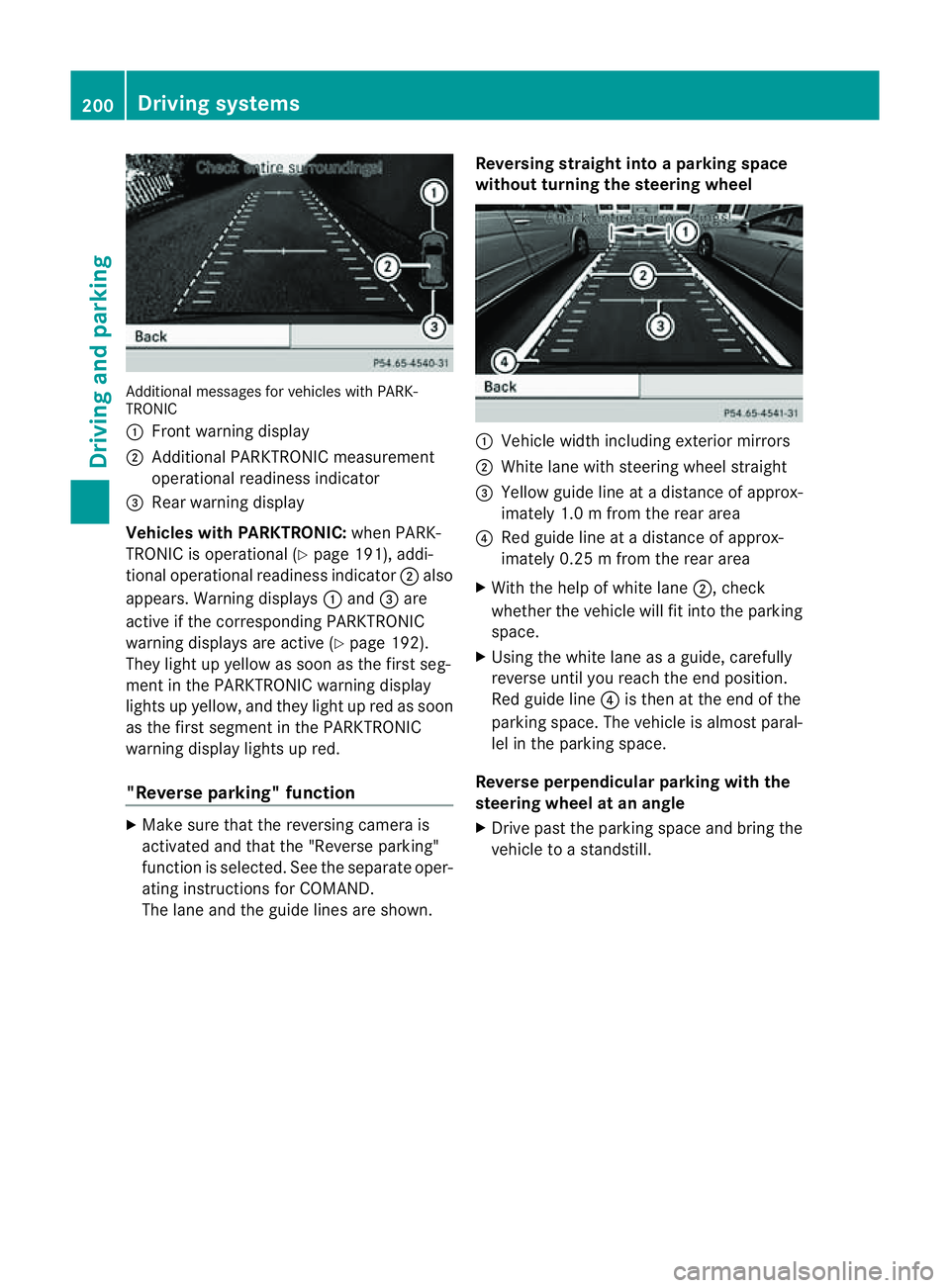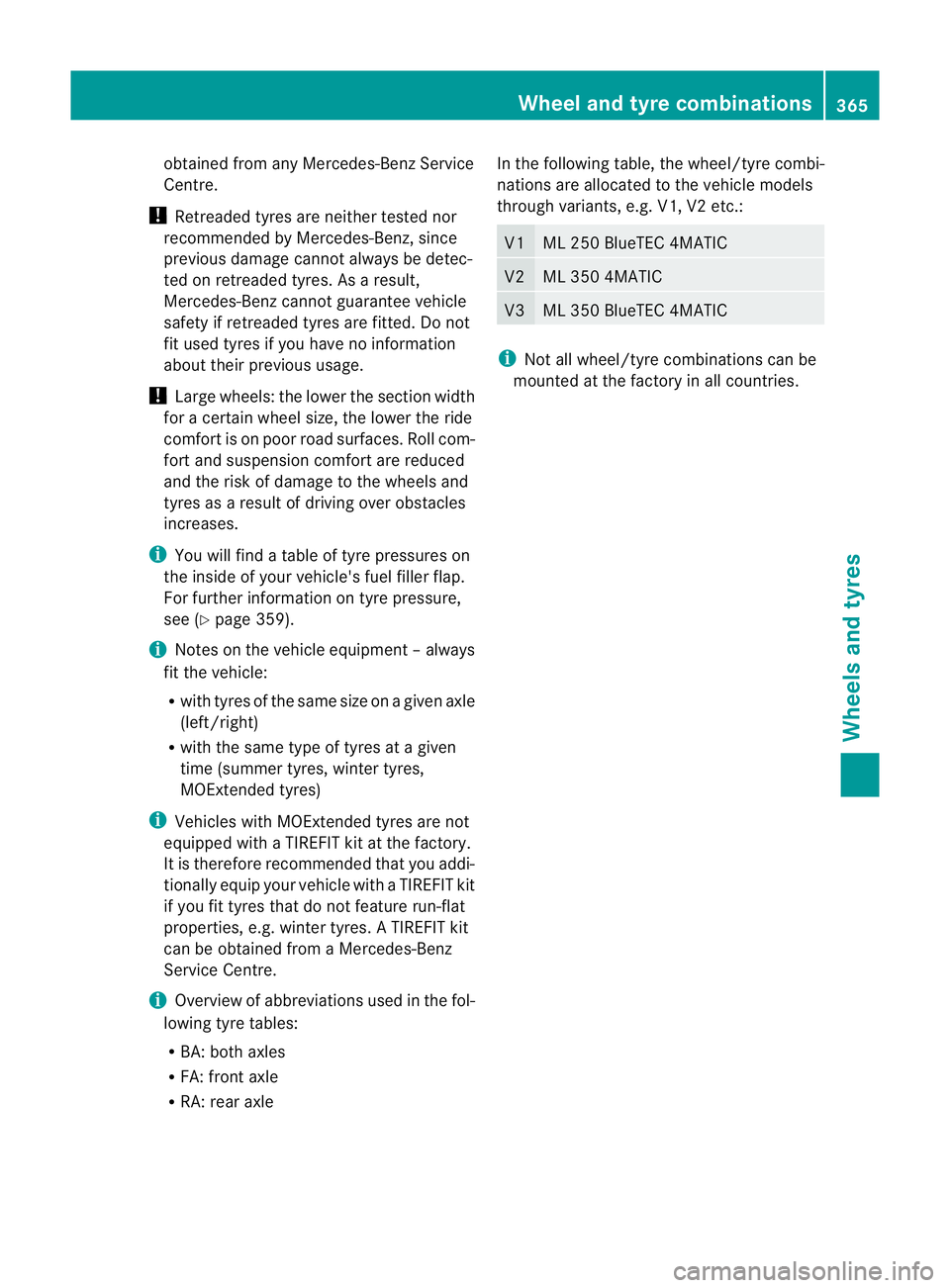2011 MERCEDES-BENZ M-CLASS SUV width
[x] Cancel search: widthPage 185 of 389

Cornering, going into and coming out of a
bend The ability of
DISTRONICPLUStod etect vehi-
cles when cor nering is limited. Your vehicle
may brake unexpectedl yorlate.
Vehicles travelling on adifferent line DISTRONIC PLU
Smay not detec tvehicles
travelling on adifferent line. The distance to
the vehicle in fron twill be too short.
Other vehicles changing lane DISTRONIC PLU
Shas not detected the vehi-
cle cuttin ginyet. The distanc etothis vehi cle
will be too short.
Narrow vehicles DISTRONIC PLUS has not yet detec
tedt he
vehi cleinf ront on th eedge of the car riage-
way, because of its narrow width. The dis-
tanc etot he vehicle in front will be too short.
Obstruction sand sta tionary vehicles DISTRONIC PLUS does not brake for obsta-
cles or stationary vehicles. If, for example, the
detected vehicle turns
acorner and reveals
an obstacle or stationar yvehicle, DI STRONIC
PLUS will not brake for these. 182
Driving systemsDrivin
gand parking
Page 202 of 389

tion. See the separate COMAND operating
instructi
ons.
The symbo lofthe selected function is high-
lighted.
To deactivate: the reversing camera is deac-
tivated if you:
R shift the transmission to position P
R drive forward ten metres
R shift the transmission from position Rto
anothe rposition (after 15 seconds)
R drive forwards at aspeed of over
10 km/h
Displays in the COMAN Ddisplay G
WARNING
Usin gthe reversing camera can be dangerous
if you ar ecolour-blin dorify our ability to dis-
tinguish colours is impaired.
Only use the reversin gcamera if you can see
and distinguis hbetween all the coloured
guide lines that are displayed by the reversing
camera in the COMAN Ddisplay. G
WARNING
Please note that objects not at ground level
may appea rtobefurther away than they
actually are. Thes einclude:
R the bumper of avehicle that is parked
behind your vehicle
R at railer drawbar
R theb all coupling of atrailer tow hitch
R thet ail-end of alorry
R slanted posts
The lines are only guides, not accurate meas-
urements of the distance to an obstacle.
Therefore, you should never pass the red line
when approachin ganobstacle. You could oth-
erwise cause an accident and injur eyourself
and others. :
Vehicle width includin gexterior mirrors
; Vehicl ewidth including wheel extremities
= Yellow guide line at adistance of approx-
imately 4.0 mfrom th erear area
? Red lane of vehicle width at curren tsteer-
ing whee langle (dynamic)
A Yellow lane of tyres at current steering
wheel angle (dynamic)
B Bumper
C Red guid eline at adistance of approx-
imately 0.2 5mfrom th erear area
D Yellow guide line at adistance of approx-
imately 1.0 mfrom th erear area
E White lane of vehicle width with steering
wheel straight (static)
F Vehicle centre axle (marker assistance)
The guide lines are only shown when the
transmission is in position R.
The distance specification sonly appl yto
objec tsthat are at ground level. Driving systems
199Drivingand park ing Z
Page 203 of 389

Additiona
lmessages for vehicles with PARK-
TRONIC
: Fron twarning display
; Additiona lPARKTRONIC measurement
operationa lreadiness indicator
= Rear warning display
Veh icleswithP ARKTRONIC: when PARK-
TRONIC is operationa l(Y page 191), addi-
tional operat iona lreadiness indicator ;also
appears. Warning displays :and =are
active if the corresponding PARKTRONIC
warning displays are active (Y page 192).
They ligh tupy ellow as soon as th efirst seg-
men tint he PARKTRONIC warnin gdisplay
lights up yellow, and they light up red as soon
as the first segment in the PARKTRONIC
warnin gdispla ylights up red.
"Reverse parking" function X
Make sure that the reversing camera is
activated and that the "Reverse parking"
func tion is selected. See the separate oper-
atin ginstructions for COMAND.
The lane and the guid elines are shown. Reversing straight into
aparking space
without turnin gthe steering wheel :
Vehicl ewidth including exterior mirrors
; White lane with steering wheel straight
= Yellow guide line at adistance of approx-
imately 1.0 mfrom th erear area
? Red guide line at adistance of approx-
imately 0.2 5mfrom th erear area
X With the help of white lane ;,check
whether the vehicle will fit int othe parking
space.
X Using the white lan easaguide, carefully
reverse until you reach the end position.
Red guide line ?is then at the end of the
parking space. The vehicle is almost paral-
lel in the parking space.
Reverse perpendicular parking with the
steering wheel at an angle
X Drive past the parking space and bring the
vehicle to astandstill. 200
Drivin
gsystemsDrivin gand parking
Page 212 of 389

Mon
itoring range of the sensors
Blind Spot Assist monitors the area up to
three metres behind you rvehicle and direc tly
next to you rvehicle, as shown in the diagram. G
WARNING
Blin dSpot Assist monitors cer tain areas in the
immediate vicinit yofyour vehicle. Vehicles
that approach and driv epast at high speeds
are not detected. There is no display and no
warning.
If the lanes are very wide, it may not be pos-
sible to monitor the complete width of the
neighbouring lane. For this reason, vehicles in
the next lane may not be detected, especially
if they are driving in astaggered formation in
different lanes .This ma ybethe case if vehi-
cles ar edriving at th eedge of their lane that
is furthest away from your vehicle.
Alway spay attention to traffic conditions and
your surroundings. Otherwise ,you may fai lto
recognis edangers in time, cause an accident
and injure yourself and others.
If the lanes are narrow, vehicles driving in the
lane beyond the lane next to your vehicle may
be indicated, especially if the vehicles are not
driving in the middle of their lane. This may
be the case if the vehicles are driving on the
inner side of their lane. Due to the nature of the system:
R
warnings may be issue dine rror when driv-
ing close to cras hbarriers or similar solid
lane borders.
R warnings may be interrupted when driving
alongside long vehicles, such as lorries, for
ap rolonged time.
Th et wo sensors for Blind Spot Assist are
integrated into the sides of the rear bumper.
Make sure that the bumper is free of dirt, ice
or slush in the vicinit yofthe sensors. The
radar sensor smust not be covered, for exam-
ple by cycle racks or overhanging loads .Fol-
lowin gasevereimpact or in th eevent of dam-
ag etot he bumpers, hav ethe func tion of the
radar sensor schecked at aqualified special-
ist workshop, e.g. aMercedes-Ben zService
Cent re.B lind Spot Assist may otherwise not
work properly.
Indicator and warning display :
Yellow indicator lamp/red warnin glamp
If Blind Spot Assis tiss witched on, indicator
lamp :in the exterior mirror slights up yel-
low up to aspeed of 30 km/h. At speeds
above 30 km/h, the indicator lamp goes out
and Blin dSpot Assist is operational.
If av ehicle is detected within the monitoring
range of Blin dSpot Assist at speeds above
30 km/h, warning lamp :on the cor re-
spondi ngside light supinred. This warning is
always emit tedw hen avehicle enters the
blind spot monitorin grange from behind or
from the side. When you overtake avehicle, Driving systems
209Drivingand parking Z
Page 216 of 389

G
WARNING
Active Blind Spo tAssist monitor scertain
areas in the immediate vicinity of your vehicle.
Vehicles that approach and drive past at high
speeds are not detected. No visual nor audi-
ble warnings are emitted and the syste mdoes
not brake the vehicle to cor rect your course.
If the lane sare very wide, it may not be pos-
sibl etom onitor the complet ewidth of the
neighbourin glane. For this reason, vehicles in
the nex tlane may not be detected, especially
if they are driving in astaggered formation.
Thi sm ay be the case if vehicles are driving at
the edge of their lane that is furthest away
from your vehicle.
Always pay attention to traffic conditions and
your surroundings. Otherwise, you may fail to
recognise dangers in time, cause an accident
and injure yourself and others.
If the lanes are narrow, vehicles driving in the
lane beyond the lane nex ttoyour vehicle may
be indicated, especially if the vehicles ar enot
drivin ginthe middle of their lane. This may
be the case if ther eare vehicles at th eedge
of their lane nearest your vehicle. Due to the nature of the system:
R
warnings may be issued in error when driv-
ing close to crash barriers or simila rsolid
lane borders.
R warnings ma ybeinterrupted whe ndriving
alongsid elong vehicles, such as lorries, for
ap rolonged time.
Tw oA ctive Blind Spo tAssist radar sensors
ar ei ntegrated into the front and rear bumpers
respectively. An additional radar sensor is
locate dbehind the cover in the radiator grille.
Make sure that the bumper sare free of dirt,
ice or slus haround th esensors. The rear sen-
sors must not be covered, e.g. by bicycle
racks or overhanging loads. Followin ga
severe impac torinthe even tofdamage to
the bumpers, have the function of the radar
sensors checked at aqualified specialist
workshop. Blind Spot Assis tmay otherwise
not work properly.
Indicator and warning display :
Yellow indicator lamp/red warning lamp
When Active Blind Spot Assis tisa ctivated,
indicator lamp :in the exte rior mirror slights
up in yellow at speeds of up to 30 km/h. At
speeds above 30 km/h, the indicator lamp
goes out and Active Blind Spot Assist is
operational.
If av ehicle is detected within the monitoring
range of Blin dSpot Assist at speeds above
30 km/h, warning lamp :on the corre-
sponding side lights up red. This warning is
always emit tedw hen avehicle enter sthe
blin dspot moni toring range from behind or Drivin
gsystems
213Drivingand park ing Z
Page 368 of 389

obtained from any Mercedes-Benz Service
Centre.
! Retreaded tyres ar eneither tested nor
recommended by Mercedes-Benz, since
previous damage can nota lways be detec-
ted on retreaded tyres. As aresult,
Mercedes-Benz can notg uarantee vehicle
safety if retreaded tyres are fitted. Do not
fit used tyres if you have no information
about their previous usage.
! Large wheels: the lower the section width
for acertain wheel size, the lower the ride
comfor tisonp oor roadsurfaces. Roll com-
fort and suspensio ncomfort ar ereduced
and the risk of damage to the wheels and
tyres as aresult of driving over obstacles
increases.
i You will fin datable of tyre pressures on
the inside of your vehicle's fuel filler flap.
For further information on tyre pressure,
see (Y page 359).
i Notes on the vehicle equipment –always
fit the vehicle:
R with tyre softhe sam esize on agiven axle
(left/right)
R with the same type of tyre satagiven
tim e(sum mertyres, winter tyres,
MOExtended tyres)
i Vehicles with MOExtended tyre sare not
equippe dwithaTIREFIT kit at th efactory.
It is therefore recommended that you addi-
tionally equip your vehicle with aTIREFIT kit
if yo ufit tyre sthat do not fea ture run-flat
prope rties, e.g. winter tyres. ATIREFIT kit
can be obtaine dfrom aMercedes-Benz
Servic eCentre.
i Overview of abbreviation sused in the fol-
lowin gtyre tables:
R BA: both axles
R FA: front axle
R RA: rear axle In the following table, the wheel/tyre combi-
nations are allocate
dtothe vehicle models
through variants, e.g. V1 ,V2etc.: V1
V2
V3
i
Not all wheel/tyre combinations can be
mounted at the factory in all countries. Wheel and tyr
ecombinations
365Wheels andtyres Z
ML 25
0BlueTEC 4MATIC
ML 350 4MATIC
ML 350 BlueTEC 4MATIC
Page 380 of 389

Coolant
Important safety notes The coolan
tisamixture of water and anti-
freeze/corrosio ninhibitor. It performs the
following tasks:
R anti-corrosio nprotection
R antifreeze protection
R raising th eboiling point
i When the vehicle is first delivered, it is fil-
led with acoolant mixtur ethat ensures
adequate antifreeze and corrosion protec-
tion.
! Only add coolant that has been premixed
with the desired antifreeze protection. The
engin ecould otherwise be damaged.
Further information on coolants and on fill-
ing can be found in the Mercedes-Benz
Specifications for Servic eProducts ,MB
Approval 310.1 ,e.g. on the Internet at
http ://bevo.mercedes-benz.com .You can
also consult aMercedes-Benz Service
Centre.
! Alway suseasuitable coolant mixture,
even in countries where high temperatures
prevail.
Otherwise, the engine cooling system is not
sufficiently protected from corrosion and
overheating.
If antifreeze/corrosio ninhibitor is present in
the correc tconcentration, the boilin gpoint of
the coolant during operation will be around
13 0†.
The antifreeze/ corrosion inhibitor con centra-
tion in the engine cooling system should:
R be at leas t50%. This wil lprotect the engine
coolin gsystem agains tfreezin gdown to
around -3 7†.
R not excee d55% (antifreeze protection
down to -45 †);otherwise, heat will not be
dissipated as effectively.
If the vehicle has los tcoolant, top it up with
equal amount sofwater and antifreeze/cor- rosion inhibitor. Mercedes-Benz recom-
mends an antifreeze/corrosion inhibitor
which has been approved for Mercedes-Benz.
! The engin ecoolin gsystem is filled with
coolant that must be renewed after 15
years, or after 250,000 km at the lates t. Vehicl
edata
Pleas enotet hat for the speci fied vehicle
data:
R the height sspecified may var yasaresult
of:
- tyres
- load
- conditio nofthe suspen sion
- optional equipment
R item sofo ptional equipmen tincrease the
unlade nweight and reduc ethe maximum
payload. The unladen weight is speci fied in
accordanc ewith EC directive and includes:
- driver (68 kg)
- luggage (7 kg)
- all fluids (fuel tan k90% full)
R veh icle-specific weigh tinformation can be
found on the vehicl eidentification plate
(Y page 37 2).
R only for cer tain countries: you can find vehi-
cle-specific vehicle data in the COC docu-
ment s(CERTIFICATE OF CONFORMITY).
Thes edocuments ar edelivered with your
vehicle.
Missing values were not available at tim eof
going to print. All models
Vehicle lengt
h(ECE) 480
4mm Vehicle width
including exterior
mirrors
214
1mm Vehicle width with-
out exterior mirrors 192
6mm Vehicl
edata
377Techni caldata Z